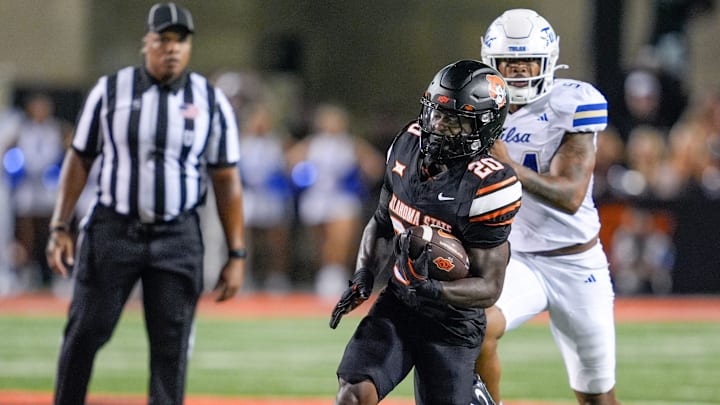As Oklahoma State continues to navigate life after Mike Gundy and search for an offensive identity, one thing has become increasingly clear: the offense needs to run through the running backs. The combination of Trent Howland and Rodney Fields Jr. may not only be the most consistent part of the Cowboys' attack, it might be the foundation upon which the entire season should be built.
The Perfect Complement: Howland’s Power, Fields’ Versatility
Trent Howland, the senior back who had seen limited touches early in the season, finally received a meaningful role against Baylor and made the most of it. At 6-foot-3 and nearly 240 pounds, Howland is a bruising runner who can churn out tough yards, convert short-yardage situations, and wear down defenses. He’s the kind of back that brings stability to an offense as someone who can handle 15–20 carries if needed and serve as a tone-setter between the tackles.
On the other hand, Rodney Fields, just a freshman, has shown flashes of brilliance in both the run and pass game. With his speed, shiftiness, and natural vision, Fields already looks like the most dynamic offensive weapon on the roster. What makes his emergence even more promising is that he doesn’t need to be overworked right away. With Howland handling the heavier load, Fields can be used strategically by maximizing his touches and keeping defenses off balance.
Together, they offer Oklahoma State the kind of backfield versatility that many Big 12 teams struggle to defend.
A Backfield That Supports the Quarterback
No matter who lines up at quarterback, whether it’s Zane Flores now or Hauss Hejny when he returns from injury, having a reliable run game is critical for development and consistency. Flores, still settling into his role, looked more comfortable when the Cowboys established the ground game. That balance opened up play-action, gave him cleaner pockets, and reduced the pressure to carry the offense by himself.
A run-first approach built around Fields and Howland will do wonders for both current and future quarterbacks. It helps slow the game down, control the clock, and set up manageable second and third downs — something this team has struggled with throughout the early part of the season.
Fields Is the Future — But No Need to Rush
Seems to be that Rodney Fields Jr. is the future of the Oklahoma State offense. His burst, versatility, and football IQ have already turned heads, and his ceiling appears higher than any other skill player on the roster. But there's no need to overload him just yet.
With Howland in the mix, Fields can continue to learn, grow, and ease into the grind of college football. This kind of setup allows him to develop naturally, without risking overuse or injury, and gives him a veteran presence to model his preparation and work ethic after.
Doug Meachem, now with more control as interim head coach, may be tempted to ride the hot hand and in Fields’ case, that’s understandable. But for now, a split backfield is the smartest path forward, giving both players roles that maximize their strengths while also supporting the bigger picture.
Building Toward Something Bigger
If Oklahoma State is going to salvage this season and lay the groundwork for the future, it starts with a clear, consistent offensive identity. And right now, there’s no question that identity should revolve around the run game. Not only does it suit the current personnel, but it also buys time for the rest of the offense, particularly the quarterback room, to grow into their roles.
As Hauss Hejny works his way back and Zane Flores continues to find his rhythm, Fields and Howland can carry the load. And if Meachem continues to build around this backfield, don’t be surprised if the Cowboys find a more consistent offensive flow in the second half of the season.
The blueprint is there. Now it’s about committing to it week in and week out.
